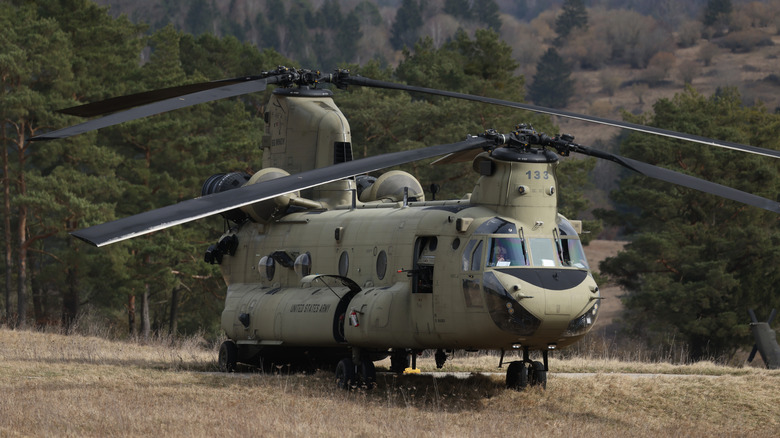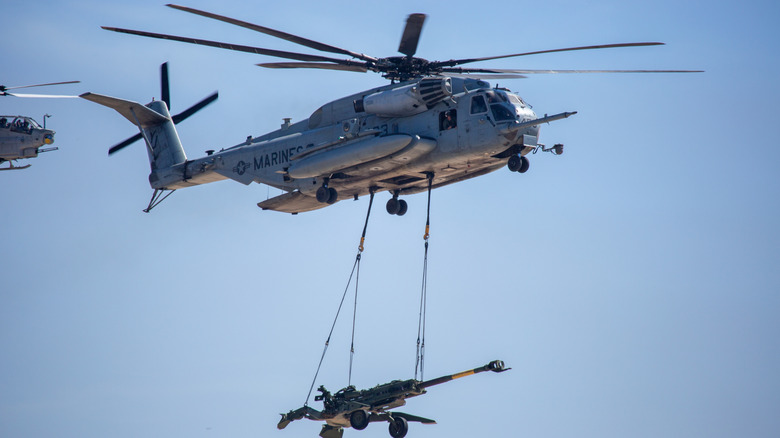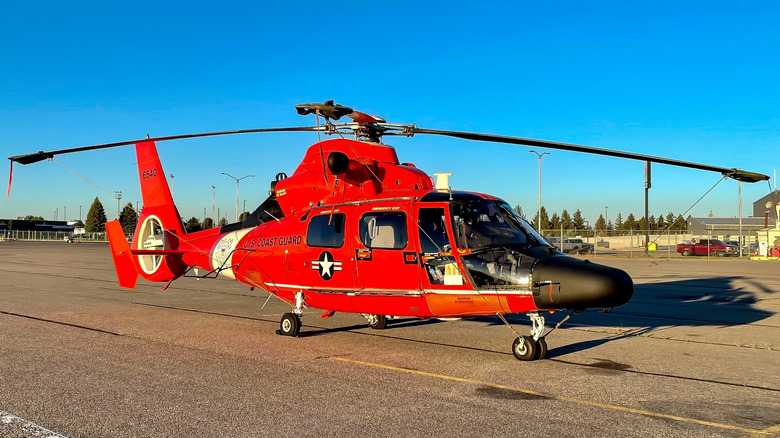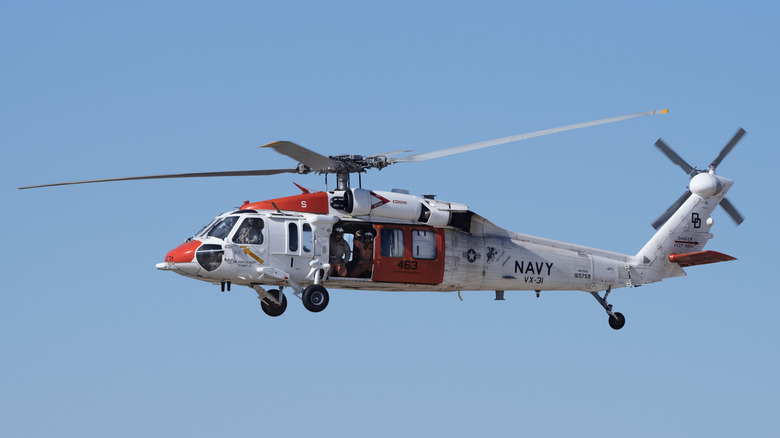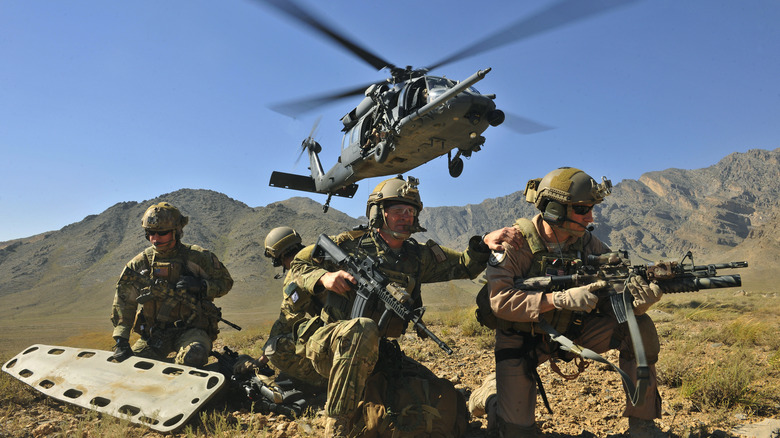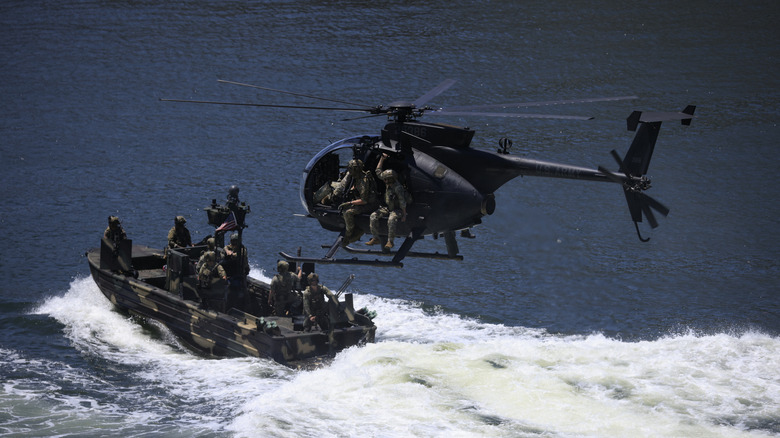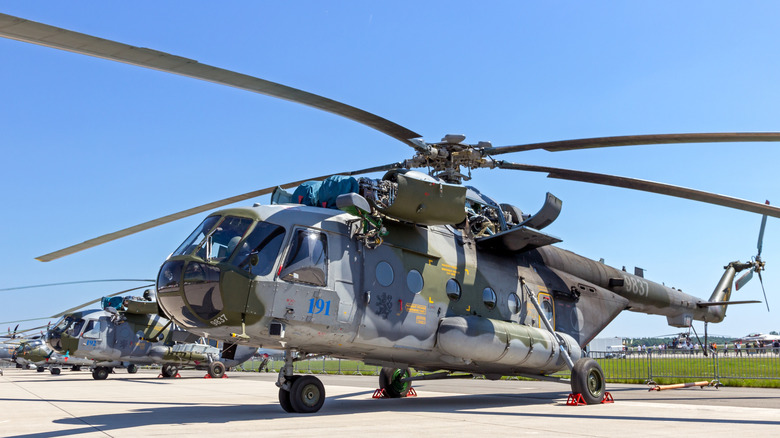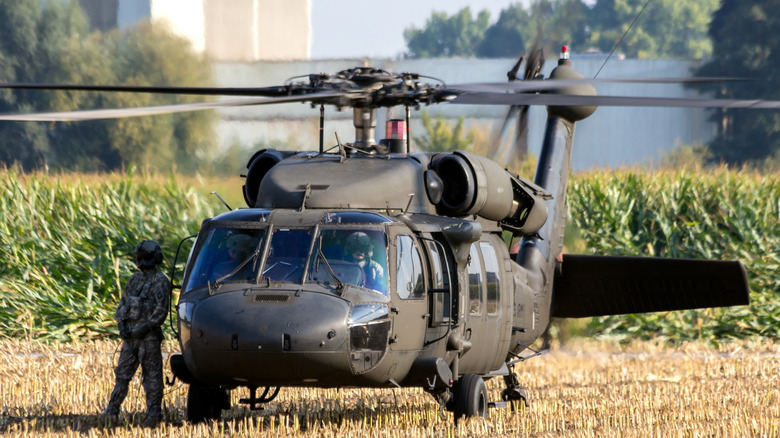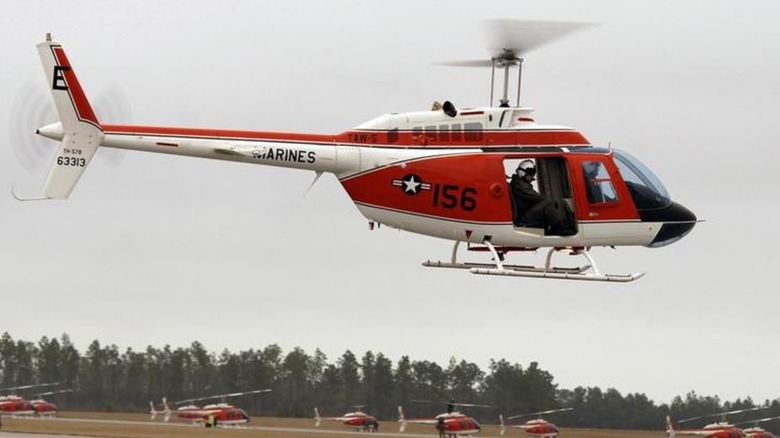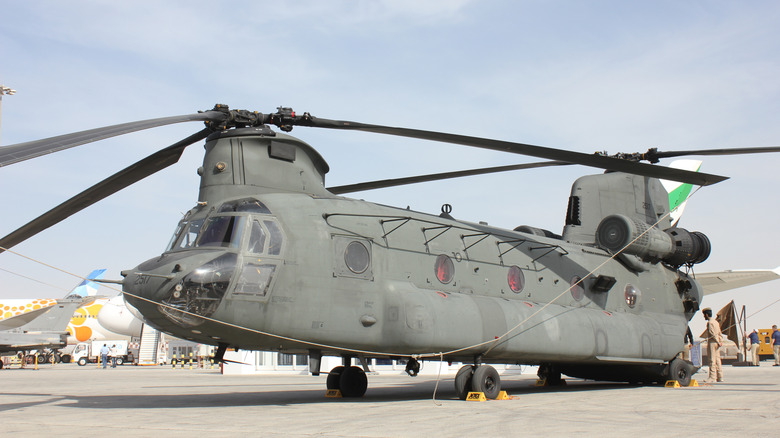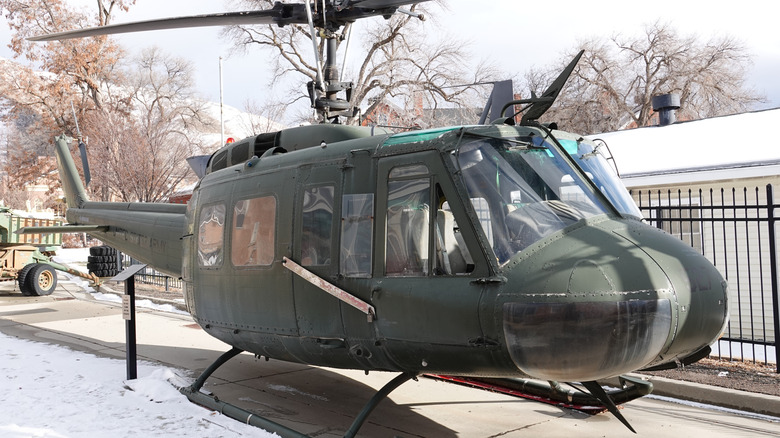The Oldest Helicopters The U.S. Military Still Uses, Ranked By Year Introduced
War. War never changes. Except when it does. Armies across the globe frequently adopt innovative technologies to stay ahead of the curve and gain the advantage over enemies. Sometimes technologies were created just for the military, other times existing tech is adopted to transform a military. But sometimes, even the military abides by the classic rule: if it ain't broke, don't to fix it.
Helicopters have been a part of the U.S. military since the early 1940s. The Sikorsky R-4B Hoverfly was the first one to serve the U.S. Air Force and also the world's first production helicopter. While it wasn't used for very long, subsequent designs proved so successful that different branches of the U.S. military relied on them for way longer than you might expect. For instance, the Bell AH-1 Cobra was the oldest attack helicopter in the U.S. military, introduced in 1967 and staying in production until 2019. However, even with that impressive service record, it isn't the oldest helicopter in the armed forces. Plenty of downright ancient helicopters are still in use, and if the top brass has anything to say about it, many may still have a good decade or so of duty left.
Here are 10 of the oldest helicopters still in use by the U.S. military.
CH-53E Super Stallion/MH-53E Sea Dragon — 1986
A variety of elements and features can impact the classification of U.S. military aircraft. Sometimes the deciding factor in naming it is really just which branch of the military uses which helicopter.
The CH-53E Super Stallion and the MH-53E Sea Dragon are different names for the same helicopter, although as indicated by their designations, these vehicles fill different roles. Whereas the Super Stallion is a "heavy-lift helicopter" that can carry up to 16 tons of cargo, the Sea Dragon is primarily assigned to mine hunting and destruction missions. However, the Sea Dragon can also serve "heavy-lift" roles in a pinch. So why do these virtually identical helicopters have different names? Because the Super Stallion transports U.S. Marine forces and equipment, while the Sea Dragon sweeps mines for the U.S. Navy.
As they are two sides of the same coin, the CH-53E Super Stallion and the MH-53E Sea Dragon have the same beginning. A prototype helicopter was introduced on December 23, 1981, and the vehicle entered full-scale service in 1986. Approximately 152 Super Stallions and 46 Sea Dragons are in operation. As of 2019, the U.S. Military plans on keeping these helicopters combat ready through at least 2031 — a potentially difficult plan seeing as how the Super Stallion has a high accident rate, just like its predecessor the Sea Stallion.
MH-65 Dolphin — 1984
When most people are asked to name the branches of the U.S. military, they probably accurately list the Army, Navy, Air Force, and the Marines. However, many probably forget the United States Space Force, the National Guard, and the Coast Guard. Despite being comparatively undersung, these branches have their own fleets of vehicles, including helicopters.
The MH-65 Dolphin is a short-range recovery helicopter employed by the United States Coast Guard. Originally based on the French Eurocopter AS365 Dauphin (which means both "heir to the throne" and "dolphin" in French), the Dolphin is the U.S. Coast Guard's primary rescue helicopter, but it fills other roles in non-rescue missions, too. For these situations, each MH-65 Dolphin is equipped with machine guns and precision weapons like guided missiles. Currently, the MH-65 Dolphin is built by the American subsidiary of Airbus Helicopters, which is headquartered in both the Netherlands and France.
The United States Coast Guard has been using the MH-65 Dolphin since 1984, and the helicopter has been through several iterations. For instance, later models were outfitted with a hi-tech heads-up display known as a FLIR. The latest version, the MH-65E, began service around 2017 and featured quite a few improvements compared to previous models. These included a digital weather radar system, improved flight controls, and an all-"glass" cockpit designed to meet Federal Aviation Administration requirements. Currently, the U.S. Coast Guard has 100 MH-65 Dolphins, but over 1,000 AS365 Dauphin helicopters — which are almost identical to the MH-65 Dolphin — are used around the globe.
MH-60/SH-60 Sea Hawk — 1984
Sikorsky has a prominent place in the United States military's history. As previously stated, the company – which was sold to Lockheed Martin in 2015 – manufactured the world's first production helicopter and the Air Force's first helicopter. However, Sikorsky does not rest on its laurels.
The MH-60/SH-60 Sea Hawk is a line of helicopters employed by the Navy for a variety of missions. The helicopters are primarily designed to engage in antisubmarine, anti-surface, and electromagnetic warfare, but some models can also fulfill search-and-rescue and mine countermeasure roles in a pinch. This versatility has earned the Sea Hawk line the honor of being regarded as the Navy's "modern day workhorse."
In the 1970s, the U.S. Navy started looking to replace its prior workhorse helicopter, the Kaman SH-2 Seasprite. The solution to this problem, the SH-69B Sea Hawk, officially became operational in 1984. While that model retired in the late 2000s and early 2010s, the U.S. Navy still maintains a fleet of MH-60R and MH-60S Sea Hawks. The R variants initially entered service in 2010 and were designed for warfare capabilities, as well as medical evacuation and surveillance, whereas the S Sea Hawks became fully operational in 2016 and were primarily intended for logistics, personnel recovery, and mine countermeasures. The latest generation of Sea Hawks are packed with advanced electronics and avionics systems and are planned to remain in service until at least 2045.
HH-60G Pave Hawk — 1982
Military helicopters, like other military aircrafts, utilize a series of letters and numbers to indicate everything from their method of propulsion to their main missions. Usually, variations on a design share alphanumeric labels and are considered the same vehicle, but sometimes the differences are so stark they are considered distinct despite the shared lineage.
The U.S. Air Force's HH-60G Pave Hawk is a personnel recovery helicopter and essentially a heavily modified version of one of the most iconic military helicopters in history, the UH-60 Black Hawk (which we will discuss later). These modifications include a communications and navigation suite that utilizes satellite communications, as well as inertial navigation, global positioning, and Doppler navigational systems. This suite is (potentially erroneously) known as the Precision Avionics Vectoring Equipment, or PAVE for short, hence its name.
Development of the HH-60G Pave Hawk is irrevocably linked to the UH-60 Black Hawk. Once that helicopter was chosen as the U.S. Army's workhorse, upgrades such as PAVE were inevitable. The Pave Hawk officially entered service in 1982 and has gone on to provide evacuation coverage and humanitarian relief for a variety of situations, especially in low visibility and low illumination. Despite being newer than many helicopters on this list, the HH-60G Pave Hawk is already slowly being phased out of service and replaced by the HH-60W Jolly Green II.
AH-6/MH-6 Little Bird — early 1980s
When you think of military aircraft, armed gunships like the AH-64 Apache and the UH-60 Black Hawk probably come to mind. However, a rocket-powered sledgehammer won't solve every problem; sometimes you need a scalpel.
The AH-6 and MH-6 Little Bird (alternatively known as the Loach) are not your typical military helicopters. While these egg-shaped helis were originally built for scouting missions, the U.S. Army's 160th Special Operations Aviation Regiment primarily uses them to insert soldiers into areas where other helicopters simply can't fit, such as small rooftops or narrow roads. While the Little Bird was based on the OH-6A Cayuse — one of the worst military helicopters of all time — the AH-6 and MH-6 helicopters had much more staying power. These vehicles even inserted themselves into the pop culture zeitgeist thanks to the movie "Black Hawk Down."
While the OH-6 Cayuse was introduced in 1963, what we know as the AH-6 and MH-6 Little Bird didn't truly emerge until the early 1980s, and the helicopter's future remains, if you'll pardon the pun, up in the air. Military engineers kept Little Birds up to date with modernized glass cockpits and improved aerial performance, but the Future Attack Reconnaissance Aircraft (FARA) program was supposed to eventually supplant the helicopter line. However, in 2024, that program was canceled, forcing the U.S. Special Operations Command (SOCOM) to scramble for a suitable replacement. While Little Bird operations were supposed to wind down, the FARA fiasco has produced what SOCOM's Rotary Wing Program Executive Officer Steven Smith is calling a Little Bird "resurrection."
Mil Mi-17 — 1981
Most of the helicopters we've mentioned throughout this article were developed by U.S. companies. Even Sikorsky aircraft are considered "Made in America," even though Igor Sikorsky originally hailed from what is now Ukraine. However, if rumors are to be believed, the U.S. military stores some actual Russian helicopters for special occasions.
The Mil Mi-8 and the Mi-17 (alternatively known as the Mi-8M) are the predecessors of the largest military helicopter in the world, the Mi-24. The Mi-8 was first introduced in 1961, with the Mi-17 following in the 1970s (with full deployment beginning in 1981). These helicopters were used primarily for troop transport, med-evac, and search and rescue. Russia continues to manufacture these helicopters and improve their performance.
Now, even a cursory knowledge of geopolitics will probably have you balking at the notion of U.S. soldiers using Mi-17s. After all, this helicopter was introduced smack dab in the middle of the Cold War, and the U.S. and Russia haven't exactly been buddies for the past few decades. Well, according to news reports, civilians have spotted Mi-17s in North Carolina piloted by "a notably covert U.S. military aviation unit." Doesn't sound very covert, but these sightings were the result of emergency landings. Makes you wonder what other foreign-made helicopters the United States military has in cold storage.
S-70/UH-60 Black Hawk — 1978
No vehicle can last forever, even if it's designed for the military. For this reason, engineers are always designing variants and successors to improve on what came before. However, sometimes the original sticks around even after a supposedly superior model is introduced.
The UH-60 Black Hawk helicopter — and its commercial version, the S-70 Black Hawk — is one of the most famous helicopters ever employed by the U.S. military. According to its manufacturers, Sikorsky Aircraft, over 5,000 Hawk-style helicopters are currently used by 36 nations, and they've logged over 15 million hours' worth of flight. A major element of the Black Hawk's appeal is its versatility, not just in terms of mission capabilities but also its specs.
The original UH-60 Black Hawk entered service around 1978 or 1979, and Sikorsky is still manufacturing them. However, the company and the vehicle have evolved with the times. One of the latest standard Black Hawks is the UH-60M, which boasts improved fuel efficiency and networked drones. However, that helicopter was introduced in the mid-to-late 2000s. Virtually every U.S. military helicopter with the word "Hawk" in its name can trace its ancestry to the original UH-60 Black Hawk. This includes the HH-60G Pave Hawk and the MH-60/SH-60 Sea Hawk. And while the Pave Hawk is winding down service, the Black Hawk shows no sign of slowing down.
TH-57 Sea Ranger — 1968
Before you were allowed to ride a bicycle, you had to first master a tricycle and then a bicycle with training wheels. The same holds true with military vehicles like helicopters; before pilots are allowed to fly a UH-60 Black Hawk or an MH-6 Little Bird, they have to first earn their wings...er, rotor blades.
The TH-57 Sea Ranger, based on the Bell Jet Ranger 206, is a light observation helicopter. Or at least, it was initially designed for a light observation helicopter competition. While the Sea Ranger didn't win, the U.S. Navy found a use for the helicopter: training aviation students at the Naval Air Station Whiting Field in Milton, Florida. Hundreds of students a year fly the Sea Ranger to hone "mission-critical aviation skills," and the Navy has also used the helicopter for photo, chase, and utility missions.
Students have used the Sea Ranger since 1968, and the helicopter has undergone some slight upgrades throughout the years. These include the TH-57B and the TH-57C, which began operation in 1981 and 1982, respectively. While the U.S. military still uses the TH-57 line of helicopters at the time of writing, that could change depending on when you read this article. The Navy plans to complete retiring the Sea Ranger by the end of the fiscal year of 2025, which officially closes September 27, 2025. Once that date passes, students at the Naval Air Station Whiting Field will train exclusively with the TH-73A Thrasher.
H-47 Chinook — 1962
While a helicopter's most noteworthy feature is its large, central rotors it uses for propulsion, many people forget that almost all helicopters have a second, smaller rotor at the tail to help with stability. Helicopters that lack this secondary rotor still have two pairs of blades, but feature a different, distinct design and layout.
The H-47 Chinook is one of the most recognizable helicopters employed by the U.S Army, if not any military. This heavy-lift helicopter is immediately identifiable by its elongated body and tandem rotor design. The Chinook can carry more troops and equipment than any other helicopter in the military, but its design has one flaw: if one rotor fails, the helicopter becomes dangerously unstable. Still, that potential issue hasn't gotten in the way of the Chinook's lengthy and decorated service record.
The H-47 Chinook was initially designed by Vertol Corporation, originally Piasecki Helicopter, but Boeing took over when it purchased Vertol in 1960. Boeing then introduced the H-47 Chinook in 1962. Like every helicopter mentioned in this article, new technologies were introduced into the base Chinook design as time went on. Given its age, you might wonder when the H-47 Chinook line will finally retire, and the answer might not be within your lifetime. Current modernization plans are designed to keep the helicopter pertinent into the 2030s, but in 2015, the U.S. Army laid out plans to keep the CH-47 Chinook running for the next century. Just imagine what the helicopter will look like in the year 2115.
UH-1 Iroquois — 1959
As we established in the beginning of this article, the Bell AH-1 Cobra is the oldest attack helicopter in U.S. military history, starting its 50-plus-year tour of duty in 1967. However, it is not the oldest helicopter used by the U.S. military. That title goes to a downright ancient vehicle that is still in use (mostly).
The UH-1 Iroquois (alternately known as the UH-1 Huey) is a utility helicopter once employed by multiple branches of the U.S. military. While the Iroquois/Huey isn't equipped as a gunship, it serves equally important roles such as surveillance, disaster response, search and rescue, and airborne cable inspection.
Currently, the most up-to-date version of the UH-1 is the UH-1N, a twin-engine model introduced in 1970, but the UH-1's history dates back as far as 1959. The U.S. Navy officially retired the Huey in 2009, while the U.S. Army continued using the helicopter up until 2016. Currently, the Air Force is the UH-1N's last bastion, but not for long. This branch of the U.S. military is well into its plan to phase out the helicopter and replace it with the MH-139A Grey Wolf; the two helicopters were spotted flying in tandem earlier this year. While plenty of UH-1 Iroquois/Huey helicopters still fly to this day, few are employed by the U.S. military — most are operated by non-military agencies or U.S. allies.
